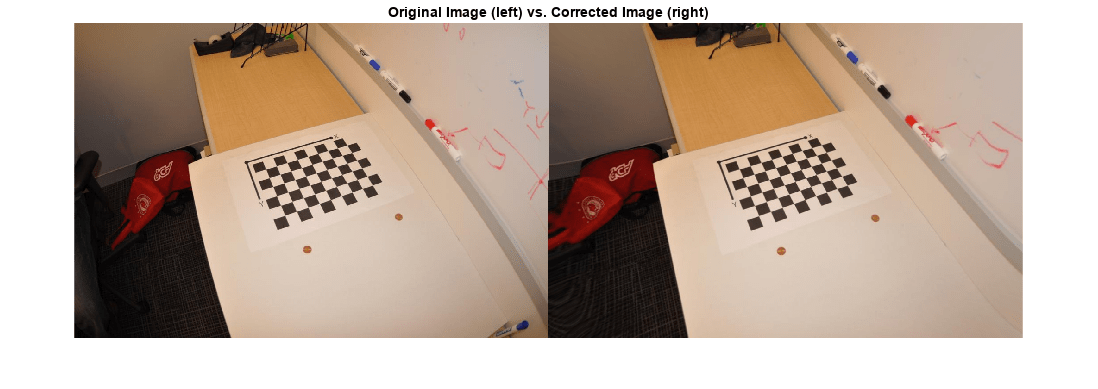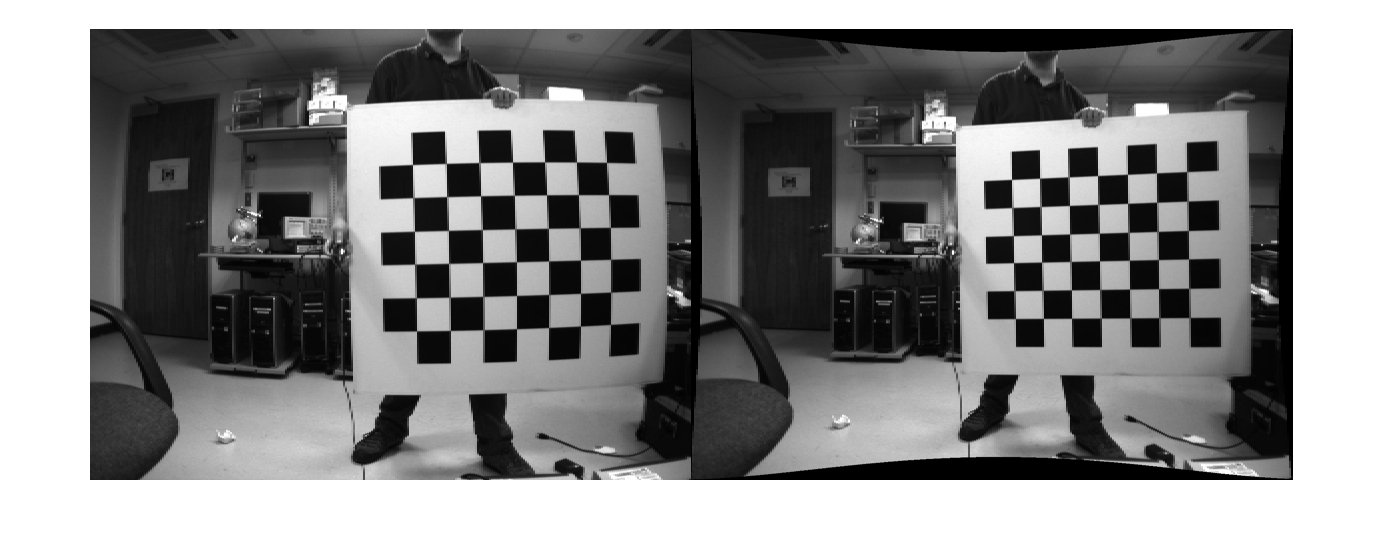cameraIntrinsicsFromOpenCV
Description
intrinsics = cameraIntrinsicsFromOpenCV(intrinsicMatrix,distortionCoefficients,imageSize)intrinsics, which can be cameraIntrinsics or cameraIntrinsicsKB.
The OpenCV spatial coordinate system specifies the upper-left pixel center at
(0,0), whereas the MATLAB spatial coordinate system specifies the pixel center at
(1,1). The cameraIntrinsicsFromOpenCV function
compensates for this difference by adding 1 to both of the x and
y-values for the converted principal point.
Examples
Define OpenCV camera intrinsic parameters in the workspace.
intrinsicMatrix = [729.4644 0 570.6455;
0 728.8196 346.0108;
0 0 1 ];
distortionCoefficients = [-0.4262 0.5460 0.0038 -0.0051 -0.6176];Define the image size returned by the camera.
imageSize = [712 1072];
Convert the intrinsic parameters from OpenCV to MATLAB format.
intrinsics = cameraIntrinsicsFromOpenCV(intrinsicMatrix, ...
distortionCoefficients,imageSize);Load the image to undistort.
filename = fullfile(toolboxdir("vision"),"visiondata","calibration", ... "mono","image01.jpg"); I = imread(filename);
Undistort the image and display the results.
J = undistortImage(I,intrinsics); imshowpair(I,J,"montage"); title("Original Image (left) vs. Corrected Image (right)");

Define OpenCV fisheye parameters in the workspace.
intrinsicMatrix = [875.88 0.00 1005.62; ... 0.00 874.76 741.52; ... 0.00, 0.00, 1.00]; distortionCoeffs = [0.08, -0.16, 0.35, -0.26];
Define the image size returned by the camera.
imageSize =[1500 2000];
Import the intrinsic camera parameters for a fisheye lens from OpenCV.
intrinsicsKB = cameraIntrinsicsFromOpenCV(intrinsicMatrix,distortionCoeffs,imageSize)
intrinsicsKB =
cameraIntrinsicsKB with properties:
FocalLength: [875.8800 874.7600]
PrincipalPoint: [1.0066e+03 742.5200]
ImageSize: [1500 2000]
DistortionCoefficients: [0.0800 -0.1600 0.3500 -0.2600]
K: [3×3 double]
Load an image to undistort.
filename = fullfile(toolboxdir("vision"),"visiondata", ... "calibration","gopro","gopro01.jpg"); I = imread(filename);
Undistort the image and display the results.
J = undistortImage(I,intrinsicsKB); imshowpair(I,J,"montage"); title("Original Image (left) vs. Corrected Image (right)");

The ROS camera calibration package estimates camera intrinsic parameters using the OpenCV camera calibration tools [1]. After calibrating a camera in ROS, you can import its intrinsic parameters to a YAML file using the camera calibration parser in ROS. To use the calibrated camera with Computer Vision Toolbox™ functions, such as undistortImage, you must read the camera parameters from the YAML file and then convert them into a cameraIntrinsics object using cameraIntrinsicsFromOpenCV.
Note: The cameraIntrinsicsFromOpenCV function supports importing camera intrinsic parameters for only those pinhole camera models that use the ROS plumb-bob distortion model.
Read Camera Intrinsic Parameters from a ROS YAML File
Read the camera parameters stored in cameraParams.yaml using the helper function helperReadYAML.
intrinsicsParams = helperReadYAML('cameraParams.yaml');Create cameraIntrinsics Object Using cameraIntrinsicsFromOpenCV
Use the cameraIntrinsicsFromOpenCV function to create a cameraIntrinsics object from the camera matrix and the distortion coefficients.
imageSize = [intrinsicsParams.image_height intrinsicsParams.image_width]; intrinsicMatrix = intrinsicsParams.camera_matrix; distortionCoefficients = intrinsicsParams.distortion_coefficients; intrinsicsObj = cameraIntrinsicsFromOpenCV(intrinsicMatrix,distortionCoefficients,imageSize);
Undistort Image
Use the imported camera intrinsics with undistortImage to undistort an image captured using the calibrated camera.
% Load the captured image. imageName = fullfile(toolboxdir('vision'),'visiondata','calibration','stereo','left','left01.png'); I = imread(imageName); % Undistort the image. J = undistortImage(I,intrinsicsObj,'OutputView','full'); % Display the result. figure montage({I,J})

Supporting Functions
helperReadYAML
The helperReadYAML function reads the monocular camera parameters from the input YAML file that was exported from ROS.
function cameraParams = helperReadYAML(filename) % helperReadYAML reads a ROS YAML file, filename, and returns a structure % with these fields: image_width, image_height, camera_name, % camera_matrix, distortion_model, distortion_coefficients, % rectification_matrix, and projection_matrix. These fields are stored % in the YAML file colon separated from their values in different lines. f = fopen(filename,'r'); stringFields = {'camera_name','distortion_model'}; while ~feof(f) [name,value,isEmptyLine] = helperReadYAMLLine(f); if isEmptyLine continue end if ~isempty(value) % Convert all values to numbers except for known string % fields. if ~any(contains(name, stringFields)) value = str2num(value); %#ok end else % An empty value in ROS YAML files indicates a matrix in % upcoming lines. Read the matrix from the upcoming lines. value = helperReadYAMLMatrix(f); end % Store post-processed value. cameraParams.(name) = value; end fclose(f); end
helperReadYAMLMatrix
The helperReadYAMLMatrix function reads the rows, columns and data fields of a matrix in the ROS YAML file.
function matrix = helperReadYAMLMatrix(f) % helperReadYAMLMatrix reads a matrix from the ROS YAML file. A matrix in % a ROS YAML file has three fields: rows, columns and data. rows and col % describe the matrix size. data is a contiguous array of the matrix % elements in row-major order. This helper function assumes the presence % of all three fields of a matrix to return the correct matrix. numRows = 0; numCols = 0; data = []; % Read numRows, numCols and matrix data. while ~feof(f) [name,value,isEmptyLine] = helperReadYAMLLine(f); if isEmptyLine continue end switch name case 'rows' numRows = str2num(value); %#ok case 'cols' numCols = str2num(value); %#ok case 'data' data = str2num(value); %#ok % Terminate the while loop as data is the last % field of a matrix in the ROS YAML file. break otherwise % Terminate the while loop if any other field is % encountered. break end end if numel(data) == numRows*numCols % Reshape the matrix using row-major order. matrix = reshape(data,[numCols numRows])'; end end
helperReadYAMLLine
The helperReadYAMLLine function reads a line of a ROS YAML file.
function [name,value,isEmptyLine] = helperReadYAMLLine(f) % Read line from file. line = fgetl(f); % Trim leading and trailing white spaces. line = strtrim(line); if isempty(line) || line(1)=='#' % Empty line or comment. name = ''; value = ''; isEmptyLine = true; else % Split the line to get name and value. c = strsplit(line,':'); assert(length(c)==2,'Unexpected file format') name = c{1}; value = strtrim(c{2}); % Trim leading white space. isEmptyLine = false; end end
References
Input Arguments
Camera intrinsic matrix from OpenCV, specified as a 3-by-3 matrix of the form:
where fx and fy are the focal lengths in the x and y-directions, and (cx,cy) is the principal point in OpenCV.
Camera distortion coefficients from OpenCV, specified as a 4-, 5-, or 8-element
vector. The function returns a cameraIntrinsics object when using extended
pinhole model distortion coefficients and a cameraIntrinsicsKB object for fisheye distortion coefficients.
Extended pinhole model — 5-element vector of the form [k1 k2 p1 p2 k3] or an 8-element vector of the form [k1 k2 p1 p2 k3 k4 k5 k6].
The values of k1, k2, …, k6 describe the radial distortion and p1 and p2 describe the tangential distortion, specified in OpenCV.
Kannala-Brandt model [1] — 4-element vector of the form [k1 k2 k3 k4]. These values are the distortion coefficients from the OpenCV fisheye camera model.
Image size, specified as a 2-element vector in the form [mrows,ncols].
Output Arguments
Camera intrinsic parameters, returned as a cameraIntrinsics or cameraIntrinsicsKB object. The function returns a cameraIntrinsics object when using extended pinhole model distortion
coefficients and a cameraIntrinsicsKB object for fisheye distortion coefficients.
cameraIntrinsicsobject — Contains OpenCV intrinsics for a pinhole camera model. In cases where the OpenCV pinhole model uses more than eight distortion coefficients, which cannot be converted to acameraIntrinsicsobject, you can recalibrate your camera using the Camera Calibrator app as an alternative solution.cameraIntrinsicsKBobject — Contains camera intrinsic calibration parameters for a fisheye lens, using the Kannala-Brandt model.
References
[1] Juho Kannala and Sami Brandt. A generic camera model and calibration method for conventional, wide-angle, and fish-eye lenses. IEEE transactions on pattern analysis and machine intelligence, 28:1335–40, 09 2006.
Extended Capabilities
C/C++ Code Generation
Generate C and C++ code using MATLAB® Coder™.
Version History
Introduced in R2021bThe cameraIntrinsicsFromOpenCV has been updated to support OpenCV pinhole camera
model with 6 radial distortion coefficients.
MATLAB Command
You clicked a link that corresponds to this MATLAB command:
Run the command by entering it in the MATLAB Command Window. Web browsers do not support MATLAB commands.
选择网站
选择网站以获取翻译的可用内容,以及查看当地活动和优惠。根据您的位置,我们建议您选择:。
您也可以从以下列表中选择网站:
如何获得最佳网站性能
选择中国网站(中文或英文)以获得最佳网站性能。其他 MathWorks 国家/地区网站并未针对您所在位置的访问进行优化。
美洲
- América Latina (Español)
- Canada (English)
- United States (English)
欧洲
- Belgium (English)
- Denmark (English)
- Deutschland (Deutsch)
- España (Español)
- Finland (English)
- France (Français)
- Ireland (English)
- Italia (Italiano)
- Luxembourg (English)
- Netherlands (English)
- Norway (English)
- Österreich (Deutsch)
- Portugal (English)
- Sweden (English)
- Switzerland
- United Kingdom (English)